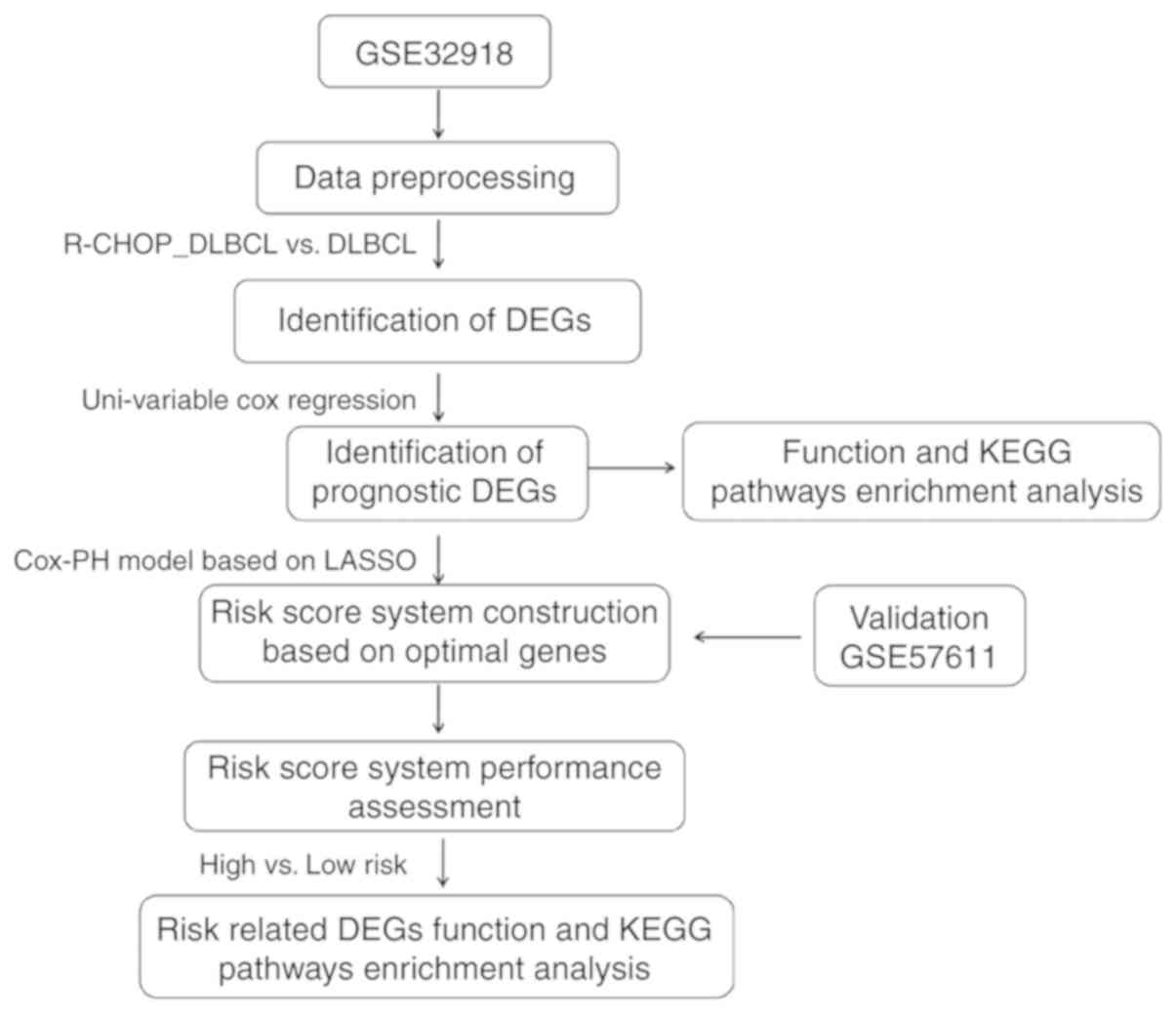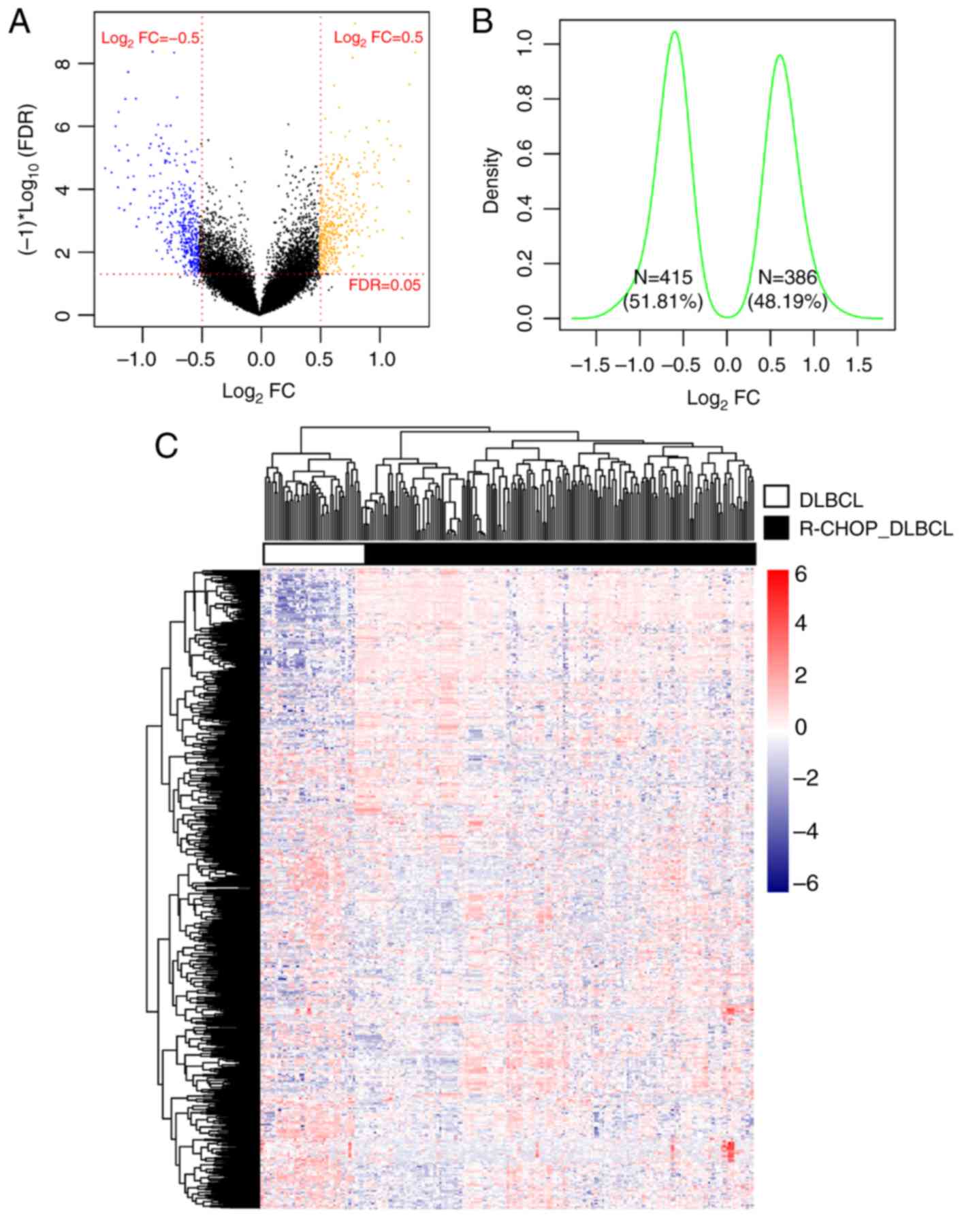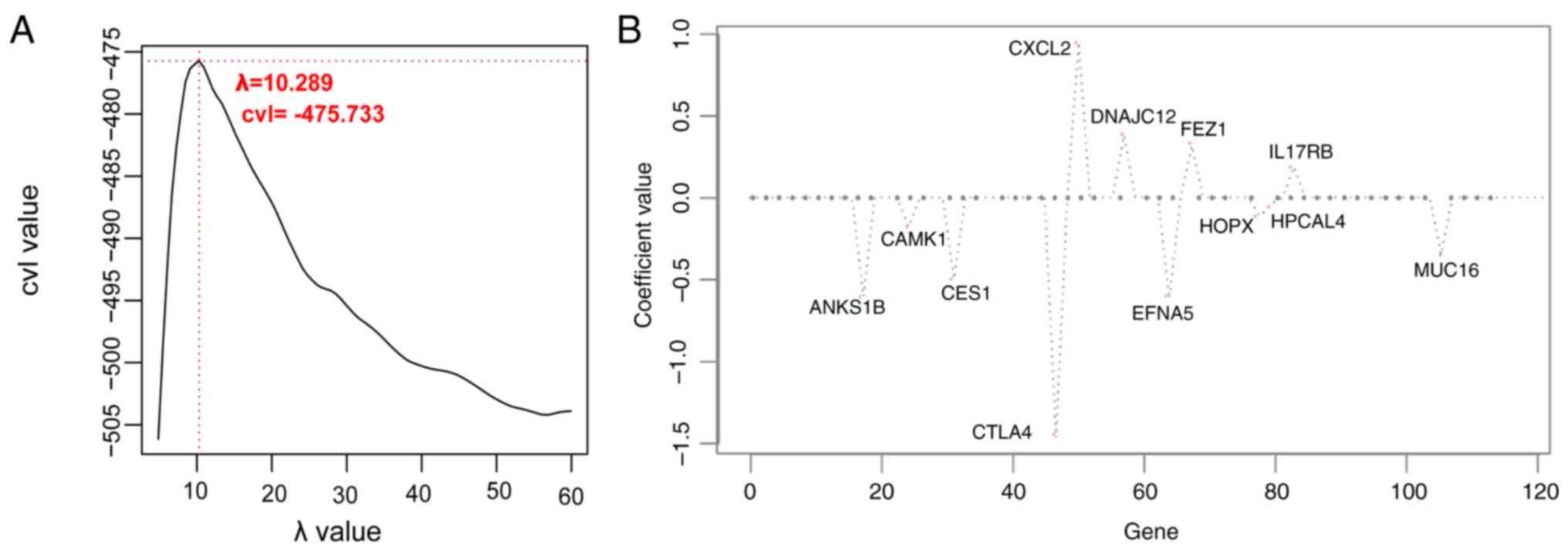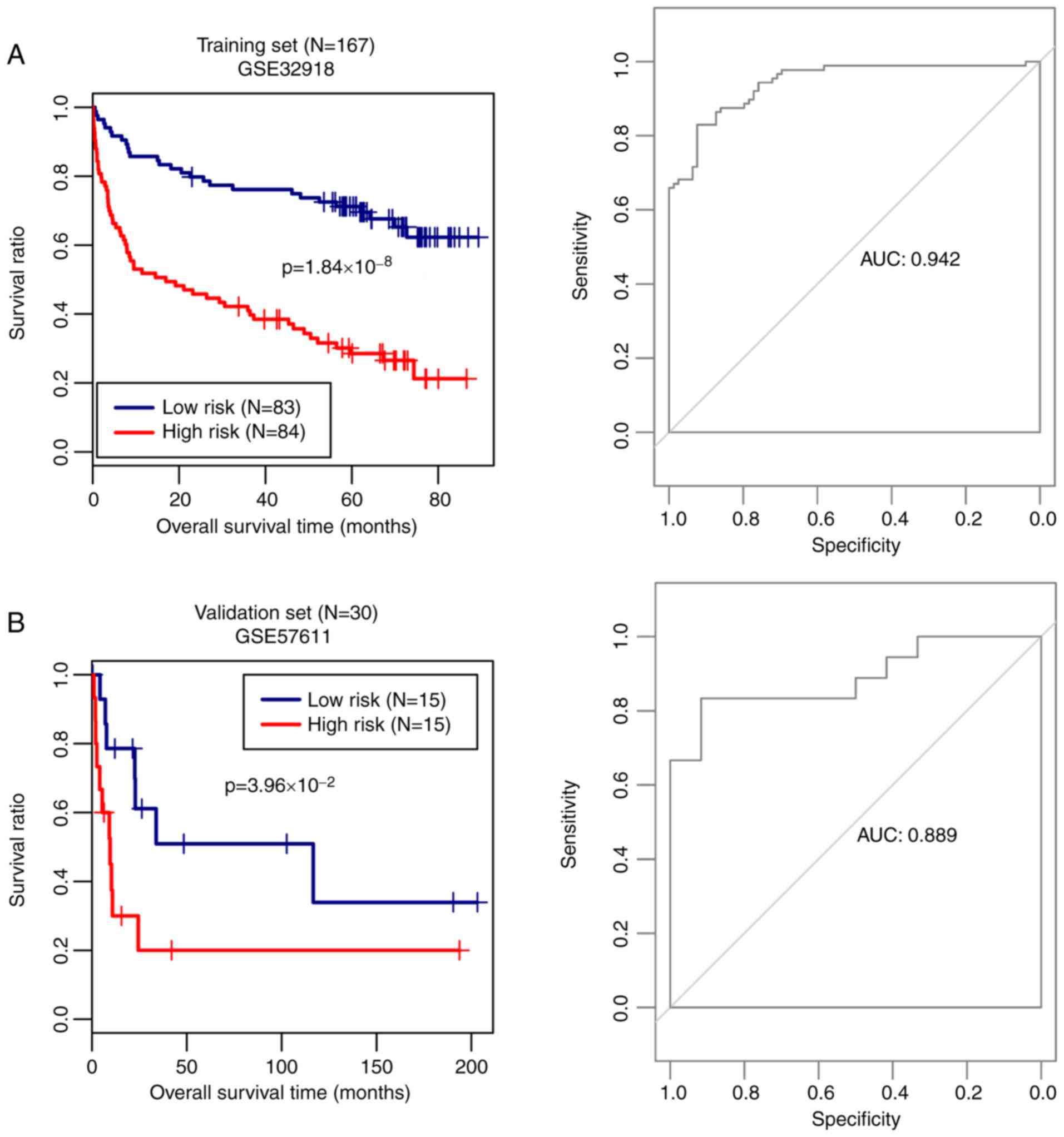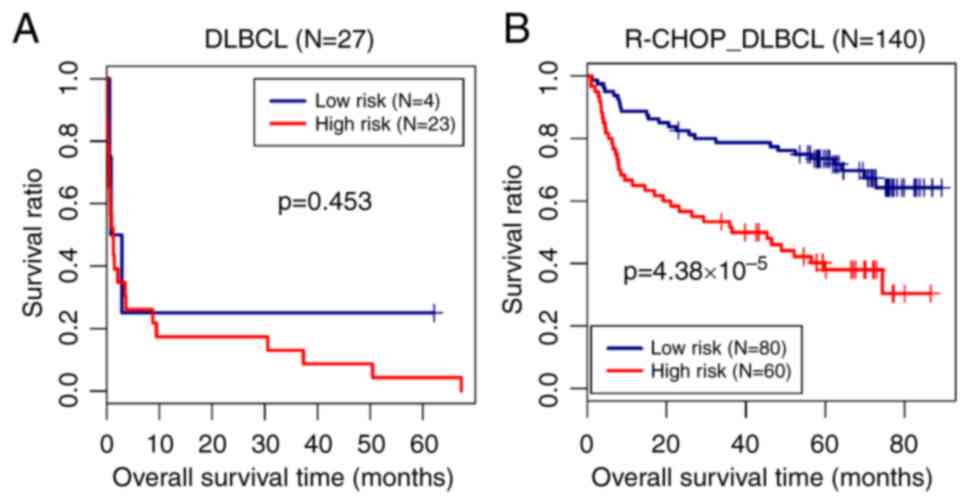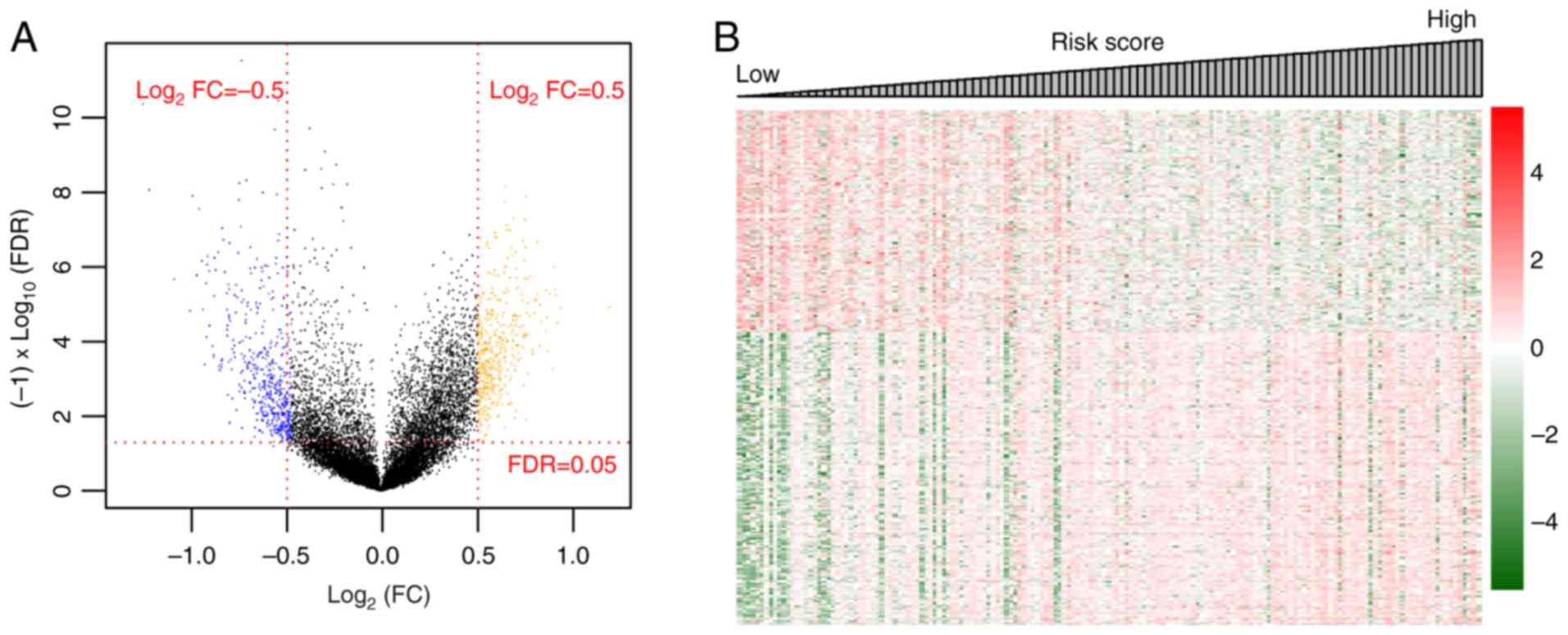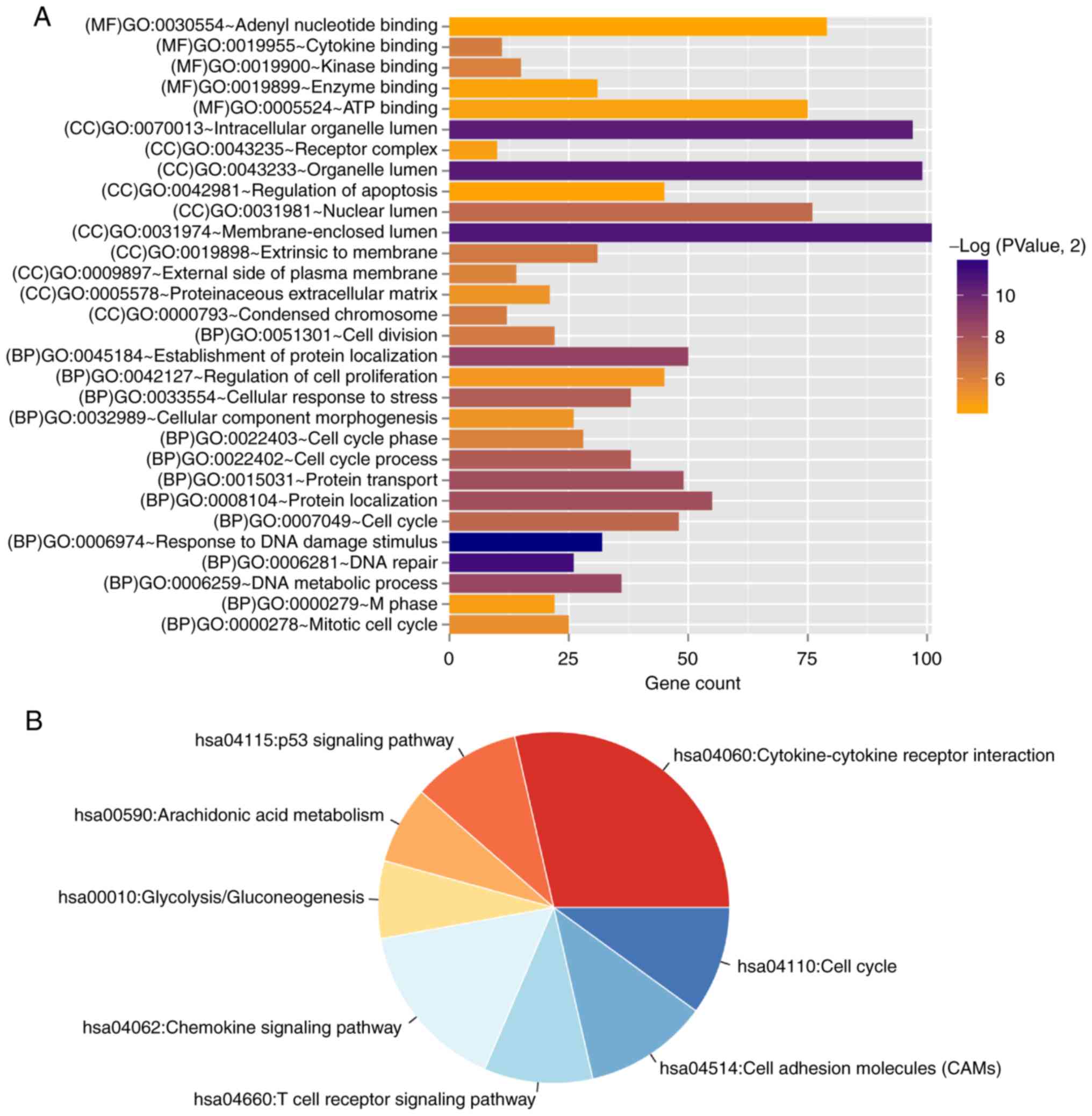|
1
|
Sabattini E, Bacci F, Sagramoso C and
Pileri SA: WHO classification of tumours of haematopoietic and
lymphoid tissues in 2008: An overview. Pathologica. 102:83–87.
2010.PubMed/NCBI
|
|
2
|
Dreyling M, Thieblemont C, Gallamini A,
Arcaini L, Campo E, Hermine O, Kluin-Nelemans JC, Ladetto M, Le
Gouill S, Iannitto E, et al: ESMO Consensus conferences: Guidelines
on malignant lymphoma. part 2: Marginal zone lymphoma, mantle cell
lymphoma, peripheral T-cell lymphoma. Ann Oncol. 24:857–877. 2013.
View Article : Google Scholar : PubMed/NCBI
|
|
3
|
Ganjoo KN, An CS, Robertson MJ, Gordon LI,
Sen JA, Weisenbach J, Li S, Weller EA, Orazi A and Horning SJ:
Rituximab, bevacizumab and CHOP (RA-CHOP) in untreated diffuse
large B-cell lymphoma: Safety, biomarker and pharmacokinetic
analysis. Leuk Lymphoma. 47:998–1005. 2006. View Article : Google Scholar : PubMed/NCBI
|
|
4
|
Patil Y, Sadhukha T, Ma L and Panyam J:
Nanoparticle-mediated simultaneous and targeted delivery of
paclitaxel and tariquidar overcomes tumor drug resistance. J
Control Release. 136:21–29. 2009. View Article : Google Scholar : PubMed/NCBI
|
|
5
|
Cultrera JL and Dalia SM: Diffuse large
B-cell lymphoma: Current strategies and future directions. Cancer
Control. 19:204–213. 2012. View Article : Google Scholar : PubMed/NCBI
|
|
6
|
Coiffier B, Lepage E, Briere J, Herbrecht
R, Tilly H, Bouabdallah R, Morel P, Van Den Neste E, Salles G,
Gaulard P, et al: CHOP chemotherapy plus rituximab compared with
CHOP alone in elderly patients with diffuse large-B-cell lymphoma.
N Engl J Med. 346:2352002. View Article : Google Scholar : PubMed/NCBI
|
|
7
|
Maloney DG, Grillo-López AJ, White CA,
Bodkin D, Schilder RJ, Neidhart JA, Janakiraman N, Foon KA, Liles
TM, Dallaire BK, et al: IDEC-C2B8 (Rituximab) anti-CD20 monoclonal
antibody therapy in patients with relapsed low-grade non-Hodgkin's
lymphoma. Blood. 90:2188–2195. 1997.PubMed/NCBI
|
|
8
|
Mclaughlin P, Grillo-López AJ, Link BK,
Levy R, Czuczman MS, Williams ME, Heyman MR, Bence-Bruckler I,
White CA, Cabanillas F, et al: Rituximab chimeric anti-CD20
monoclonal antibody therapy for relapsed indolent lymphoma: Half of
patients respond to a four-dose treatment program. J Clin Oncol.
16:2825–2833. 1998. View Article : Google Scholar : PubMed/NCBI
|
|
9
|
Habermann TM, Weller EA, Morrison VA,
Gascoyne RD, Cassileth PA, Cohn JB, Dakhil SR, Woda B, Fisher RI,
Peterson BA and Horning SJ: Rituximab-CHOP versus CHOP alone or
with maintenance rituximab in older patients with diffuse large
B-cell lymphoma. J Clin Oncol. 24:3121–3127. 2006. View Article : Google Scholar : PubMed/NCBI
|
|
10
|
National Comprehensive Cancer Network, .
NCCN Clinical Practice Guidelines in Oncology. 2003.
|
|
11
|
Pettengell R, Bosly A, Szucs TD, Jackisch
C, Leonard R, Paridaens R, Constenla M and Schwenkglenks M; Impact
of Neutropenia in Chemotherapy-European Study Group (INC-EU), :
Multivariate analysis of febrile neutropenia occurrence in patients
with non-Hodgkin lymphoma: Data from the INC-EU Prospective
Observational European Neutropenia Study. Br J Haematol.
144:677–685. 2009. View Article : Google Scholar : PubMed/NCBI
|
|
12
|
Sehn LH, Scott DW, Chhanabhai M, Berry B,
Ruskova A, Berkahn L, Connors JM and Gascoyne RD: Impact of
concordant and discordant bone marrow involvement on outcome in
diffuse large B-cell lymphoma treated with R-CHOP. J Clin Oncol.
29:1452–1457. 2011. View Article : Google Scholar : PubMed/NCBI
|
|
13
|
Barrans SL, Crouch S, Care MA, Worrillow
L, Smith A, Patmore R, Westhead DR, Tooze R, Roman E and Jack AS:
Whole genome expression profiling based on paraffin embedded tissue
can be used to classify diffuse large B-cell lymphoma and predict
clinical outcome. Br J Haematol. 159:441–453. 2012. View Article : Google Scholar : PubMed/NCBI
|
|
14
|
Scholtysik R, Kreuz M, Hummel M,
Rosolowski M, Szczepanowski M, Klapper W, Loeffler M, Trümper L,
Siebert R and Küppers R; Molecular Mechanisms in Malignant
Lymphomas Network Project of the Deutsche Krebshilfe, :
Characterization of genomic imbalances in diffuse large B-cell
lymphoma by detailed SNP-chip analysis. Int J Cancer.
136:1033–1042. 2015. View Article : Google Scholar : PubMed/NCBI
|
|
15
|
Ritchie ME, Phipson B, Wu D, Hu Y, Law CW,
Shi W and Smyth GK: limma powers differential expression analyses
for RNA-sequencing and microarray studies. Nucleic Acids Res.
43:e472015. View Article : Google Scholar : PubMed/NCBI
|
|
16
|
Li S, Sun YN, Zhou YT, Zhang CL, Lu F, Liu
J and Shang XM: Screening and identification of microRNA involved
in unstable angina using gene-chip analysis. Exp Ther Med.
12:2716–2722. 2016. View Article : Google Scholar : PubMed/NCBI
|
|
17
|
Parrish RS and Spencer HJ III: Effect of
normalization on significance testing for oligonucleotide
microarrays. J Biopharm Stat. 14:575–589. 2004. View Article : Google Scholar : PubMed/NCBI
|
|
18
|
Kaminskyi R, Kunanets N, Pasichnyk V,
Rzheuskyi A and Khudyi A: Recovery gaps in experimental data.
COLINS. 108–118. 2018.
|
|
19
|
Bolstad BM, Irizarry RA, Åstrand M and
Speed TP: A comparison of normalization methods for high density
oligonucleotide array data based on variance and bias.
Bioinformatics. 19:185–193. 2003. View Article : Google Scholar : PubMed/NCBI
|
|
20
|
Szekely GJ and Rizzo ML: Hierarchical
clustering via joint between-within distances: Extending Ward's
minimum variance method. J Classification. 22:151–183. 2005.
View Article : Google Scholar
|
|
21
|
Press W, Teukolsky S, Vetterling W and
Flannery B: Section 16.4. Hierarchical clustering by phylogenetic
trees. Numerical recipes: The art of scientific computing. 868–881.
2007.
|
|
22
|
Wang L, Cao C, Ma Q, Zeng Q, Wang H, Cheng
Z, Zhu G, Qi J, Ma H, Nian H and Wang Y: RNA-seq analyses of
multiple meristems of soybean: Novel and alternative transcripts,
evolutionary and functional implications. BMC Plant Biol.
14:1692014. View Article : Google Scholar : PubMed/NCBI
|
|
23
|
Wang P, Wang Y, Hang B, Zou X and Mao JH:
A novel gene expression-based prognostic scoring system to predict
survival in gastric cancer. Oncotarget. 7:55343–55351.
2016.PubMed/NCBI
|
|
24
|
Huang da W, Sherman BT and Lempicki RA:
Systematic and integrative analysis of large gene lists using DAVID
bioinformatics resources. Nat Protoc. 4:44–57. 2009. View Article : Google Scholar : PubMed/NCBI
|
|
25
|
Tibshirani R: THE lasso method for
variable selection in the COX model. Stat Med. 16:385–395. 1997.
View Article : Google Scholar : PubMed/NCBI
|
|
26
|
Goeman JJ: L1 penalized estimation in the
Cox proportional hazards model. Biom J. 52:70–84. 2010.PubMed/NCBI
|
|
27
|
Adjei AA and Hidalgo M: Intracellular
signal transduction pathway proteins as targets for cancer therapy.
J Clin Oncol. 23:5386–5403. 2005. View Article : Google Scholar : PubMed/NCBI
|
|
28
|
Wang D, Zhang B, Gao H, Ding G, Wu Q,
Zhang J, Liao L and Chen H: Clinical research of genetically
modified dendritic cells in combination with cytokine-induced
killer cell treatment in advanced renal cancer. BMC Cancer.
14:2512014. View Article : Google Scholar : PubMed/NCBI
|
|
29
|
Sinha A and Bagga A: Rituximab therapy in
nephrotic syndrome: Implications for patients' management. Nat Rev
Nephrol. 9:154–169. 2013. View Article : Google Scholar : PubMed/NCBI
|
|
30
|
Sfikakis P, Souliotis V, Fragiadaki K,
Moutsopoulos H, Boletis J and Theofilopoulos A: Increased
expression of the Foxp3 functional marker of regulatory t cells
following b cell depletion with rituximab in patients with lupus
nephritis. Clin Immunol. 123:66–73. 2007. View Article : Google Scholar : PubMed/NCBI
|
|
31
|
Ishii H, Baffa R, Numata SI, Murakumo Y,
Rattan S, Inoue H, Mori M, Fidanza V, Alder H and Croce CM: The
FEZ1 gene at chromosome 8p22 encodes a leucine-zipper protein, and
its expression is altered in multiple human tumors. Proc Natl Acad
Sci USA. 96:3928–3933. 1999. View Article : Google Scholar : PubMed/NCBI
|
|
32
|
Vecchione A, Ishii H, Shiao YH, Trapasso
F, Rugge M, Tamburrino JF, Murakumo Y, Alder H, Croce CM and Baffa
R: Fez1/lzts1 alterations in gastric carcinoma. Clin Cancer Res.
7:1546–1552. 2001.PubMed/NCBI
|
|
33
|
Cabeza-Arvelaiz Y, Sepulveda JL, Lebovitz
RM, Thompson TC and Chinault AC: Functional identification of LZTS1
as a candidate prostate tumor suppressor gene on human chromosome
8p22. Oncogene. 20:4169–4179. 2001. View Article : Google Scholar : PubMed/NCBI
|
|
34
|
Kikuchi M, Katoh H, Waraya M, Tanaka Y,
Ishii S, Tanaka T, Nishizawa N, Yokoi K, Minatani N, Ema A, et al:
Epigenetic silencing of HOPX contributes to cancer aggressiveness
in breast cancer. Cancer Lett. 384:70–78. 2017. View Article : Google Scholar : PubMed/NCBI
|
|
35
|
Cheung WK, Zhao M, Liu Z, Stevens LE, Cao
PD, Fang JE, Westbrook TF and Nguyen DX: Control of alveolar
differentiation by the lineage transcription factors GATA6 and HOPX
inhibits lung adenocarcinoma metastasis. Cancer Cell. 23:725–738.
2013. View Article : Google Scholar : PubMed/NCBI
|
|
36
|
Shukla SK, Gunda V, Abrego J, Haridas D,
Mishra A, Souchek J, Chaika NV, Yu F, Sasson AR, Lazenby AJ, et al:
MUC16-mediated activation of mTOR and c-MYC reprograms pancreatic
cancer metabolism. Oncotarget. 6:19118–19131. 2015. View Article : Google Scholar : PubMed/NCBI
|
|
37
|
Aithal A, Rauth S, Kshirsagar P, Shah A,
Lakshmanan I, Junker WM, Jain M, Ponnusamy MP and Batra SK: MUC16
as a novel target for cancer therapy. Expert Opin Ther Targets.
22:675–686. 2018. View Article : Google Scholar : PubMed/NCBI
|
|
38
|
Downward J: Targeting RAS signalling
pathways in cancer therapy. Nat Rev Cancer. 3:11–22. 2003.
View Article : Google Scholar : PubMed/NCBI
|
|
39
|
Slack C, Alic N, Foley A, Cabecinha M,
Hoddinott MP and Partridge L: The Ras-Erk-ETS-signaling pathway is
a drug target for longevity. Cell. 162:72–83. 2015. View Article : Google Scholar : PubMed/NCBI
|
|
40
|
Huang Y, Zhang J, Hou L, Wang G, Liu H,
Zhang R, Chen X and Zhu J: LncRNA AK023391 promotes tumorigenesis
and invasion of gastric cancer through activation of the PI3K/Akt
signaling pathway. J Exp Clin Cancer Res. 36:1942017. View Article : Google Scholar : PubMed/NCBI
|
|
41
|
Martini M, De Santis M, Braccini L,
Gulluni F and Hirsch E: PI3K/AKT signaling pathway and cancer: An
updated review. Ann Med. 46:372–383. 2014. View Article : Google Scholar : PubMed/NCBI
|
|
42
|
Mayer IA and Arteaga CL: The PI3K/AKT
pathway as a target for cancer treatment. Annu Rev Med. 67:11–28.
2015. View Article : Google Scholar : PubMed/NCBI
|
|
43
|
Nakamaki T, Baba Y, Abe M, Murai S,
Watanuki M, Kabasawa N, Yanagisawa K, Hattori N, Kawaguchi Y, Arai
N, et al: Rituximab-induced CD20-mediated signals and suppression
of PI3K-AKT pathway cooperates to inhibit B-cell lymphoma growth by
down-regulation of Myc. Blood. 128:53122016.
|
|
44
|
Nagasawa T, Hirota S, Tachibana K,
Takakura N, Nishikawa S, Kitamura Y, Yoshida N, Kikutani H and
Kishimoto T: Defects of B-cell lymphopoiesis and bone-marrow
myelopoiesis in mice lacking the CXC chemokine PBSF/SDF-1. Nature.
382:635–638. 1996. View Article : Google Scholar : PubMed/NCBI
|
|
45
|
Zhu Q, Peng J, Qin H and Yu W: The role of
CXC chemokines and their receptors in the progression and treatment
of tumors. J Mol Histol. 43:699–713. 2012. View Article : Google Scholar : PubMed/NCBI
|
|
46
|
Hunninghake GM, Chu JH, Sharma SS, Cho MH,
Himes BE, Rogers AJ, Murphy A, Carey VJ and Raby BA: The CD4+
T-cell transcriptome and serum IgE in asthma: IL17RB and the role
of sex. BMC Pulm Med. 11:172011. View Article : Google Scholar : PubMed/NCBI
|
|
47
|
Husson H, Carideo EG, Cardoso AA, Lugli
SM, Neuberg D, Munoz O, de Leval L, Schultze J and Freedman AS:
MCP-1 modulates chemotaxis by follicular lymphoma cells. Br J
Haematol. 115:554–562. 2001. View Article : Google Scholar : PubMed/NCBI
|
|
48
|
Alinejad V, Dolati S, Motallebnezhad M and
Yousefi M: The role of IL17B-IL17RB signaling pathway in breast
cancer. Biomed Pharmacother. 88:795–803. 2017. View Article : Google Scholar : PubMed/NCBI
|
|
49
|
Sharma S, Rajaram S, Sharma T, Goel N,
Agarwal S and Banerjee BD: Role of BRCA1 and BRCA2 gene mutations
in epithelial ovarian cancer in Indian population: A pilot study.
Int J Biochem Mol Biol. 5:1–10. 2014.PubMed/NCBI
|
|
50
|
Furuta S, Jeng YM, Zhou L, Huang L, Kuhn
I, Bissell MJ and Lee WH: IL-25 causes apoptosis of
IL-25R-expressing breast cancer cells without toxicity to
nonmalignant cells. Sci Transl Med. 3:78ra312011. View Article : Google Scholar : PubMed/NCBI
|
|
51
|
Pievani A, Belussi C, Klein C, Rambaldi A,
Golay J and Introna M: Enhanced killing of human B-cell lymphoma
targets by combined use of cytokine-induced killer cell (CIK)
cultures and anti-CD20 antibodies. Blood. 117:510–518. 2011.
View Article : Google Scholar : PubMed/NCBI
|
|
52
|
Venugopal P, Sivaraman S, Huang X, Nayini
J, Gregory S and Preisler H: Effects of cytokines on CD20 antigen
expression on tumor cells from patients with chronic lymphocytic
leukemia. Leuk Res. 24:411–415. 2000. View Article : Google Scholar : PubMed/NCBI
|
|
53
|
Wang X, Yang L, Huang F, Zhang Q, Liu S,
Ma L and You Z: Inflammatory cytokines IL-17 and TNF-α up-regulate
PD-L1 expression in human prostate and colon cancer cells. Immunol
Lett. 184:7–14. 2017. View Article : Google Scholar : PubMed/NCBI
|
|
54
|
Herberich SE, Klose R, Moll I, Yang WJ,
Wüstehube-Lausch J and Fischer A: ANKS1B interacts with the
cerebral cavernous malformation protein-1 and controls endothelial
permeability but not sprouting angiogenesis. PLoS One.
10:e01453042015. View Article : Google Scholar : PubMed/NCBI
|
|
55
|
Fu X, McGrath S, Pasillas M, Nakazawa S
and Kamps MP: EB-1, a tyrosine kinase signal transduction gene, is
transcriptionally activated in the t (1;19) subset of pre-B ALL,
which express oncoprotein E2a-Pbx1. Oncogene. 18:4920–4929. 1999.
View Article : Google Scholar : PubMed/NCBI
|
|
56
|
Evan GI and Vousden KH: Proliferation,
cell cycle and apoptosis in cancer. Nature. 411:342–348. 2001.
View Article : Google Scholar : PubMed/NCBI
|
|
57
|
Eckel-Passow JE, Serie DJ, Bot BM, Joseph
RW, Cheville JC and Parker AS: ANKS1B is a smoking-related
molecular alteration in clear cell renal cell carcinoma. BMC Urol.
14:142014. View Article : Google Scholar : PubMed/NCBI
|
|
58
|
Satoh T and Hosokawa M: Structure,
function and regulation of carboxylesterases. Chem Biol Interact.
162:195–211. 2006. View Article : Google Scholar : PubMed/NCBI
|
|
59
|
Redinbo MR and Potter PM: Mammalian
carboxylesterases: From drug targets to protein therapeutics. Drug
Discov Today. 10:313–325. 2005. View Article : Google Scholar : PubMed/NCBI
|
|
60
|
Pratt SE, Durland-Busbice S, Shepard RL,
Heinz-Taheny K, Iversen PW and Dantzig AH: Human carboxylesterase-2
hydrolyzes the prodrug of gemcitabine (LY2334737) and confers
prodrug sensitivity to cancer cells. Clin Cancer Res. 19:1159–1168.
2013. View Article : Google Scholar : PubMed/NCBI
|
|
61
|
Anikster Y, Haack TB, Vilboux T,
Pode-Shakked B, Thöny B, Shen N, Guarani V, Meissner T, Mayatepek
E, Trefz FK, et al: Biallelic mutations in DNAJC12 cause
hyperphenylalaninemia, dystonia, and intellectual disability. Am J
Hum Genet. 100:257–266. 2017. View Article : Google Scholar : PubMed/NCBI
|
|
62
|
Jung-KC K, Himmelreich N, Prestegård KS,
Shi TS, Scherer T, Ying M, Jorge-Finnigan A, Thöny B, Blau N and
Martinez A: Phenylalanine hydroxylase variants interact with the
co-chaperone DNAJC12. Hum Mutat. 40:483–494. 2019. View Article : Google Scholar : PubMed/NCBI
|
|
63
|
He HL, Lee YE, Chen HP, Hsing CH, Chang
IW, Shiue YL, Lee SW, Hsu CT, Lin LC, Wu TF and Li CF:
Overexpression of DNAJC12 predicts poor response to neoadjuvant
concurrent chemoradiotherapy in patients with rectal cancer. Exp
Mol Pathol. 98:338–345. 2015. View Article : Google Scholar : PubMed/NCBI
|















